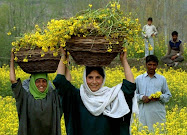Kashmir Shaivism is believed to have commenced around 8th or 9th century A.D. with the writings by Vasugupta. Since then, the written teachings of various scholars continued and some of the scriptures have become very common. Vasugupta is said to have lived near Mahadeva Mountain behind the present Shalimar Gardens near Srinagar. It’s said that Lord Shiva came in his dream and instructed him to go to a certain rock near there. He went there to find that the teachings called Shiva Sutras were inscribed on it. The rock is still there and is called Shivpal and people till now visit there to pay respects. A number of commentaries have been written by Vasugupta’s contemporaries and successors. Most famous of them is Kshemeraja’s Vimarshini (10th Century A.D) which has been translated into English by Jaideva Singh and Swami Lakshman Joo. Another is a commentary called the Varttika by Baskara (11th century) translated into English by Mark Dyczkowski. The Shaivite Master Swami Lakshman Joo Raina was recognized as the last authority of Kashmir Shaivism in the oral tradition till he passed away in 1991. He dedicated his full life to the philosophy and practice of Kashmir Shaivism, and lectured extensively on the subject for the uplift of all spiritual seekers and to preserve this great tradition for future generation.
It is a non-dual (advaita) school of philosophy which takes as its source the ninety-two Tantras of Lord Shiva. This includes the sixty-four monastic Bhairava Tantras, the eighteen mono-dualistic Rudra Tantras, and the ten dualistic Shiva Tantras. This philosophical tradition is also known by its adherents as Trika. It is called Trika because it encompasses the threefold signs of man and his world. These three signs are Shiva, his Shakti (energy), and Jiva (individual ). Also signified are three primary energies: para (supreme) energy, para-para (combination of highest and lowest) energy. and apara (lowest) energy. These are also termed iccha Shakti, the energy of will, jnana Shakti, the energy of knowledge, and kriya Shakti, the energy of action. These three energies represent the threefold activities of the world: knower, knowing, and known. Kashmir Shaivism also known as the Trika tradition encompasses four systems of philosophy: the Pratyabhijna system, the Kula system, the Krama system, and the Spanda system.
Kashmir has produced scores of lesser known scholars who have immensely contributed to the philosophy and practiced for their personal liberation. Lalleshuri (Lalded) was the great exponent of Shaivism. She has explained in her Vaakhs the terse principals of Shaivism in very simple language for the common man to follow and practice....... (to be continued)
Subscribe to:
Post Comments (Atom)
.jpg)




The three energies-the knower,knowing and known in unison help us to unfold the unknown.This basic principle of Existential or Phenomenological Philosophy is the essence of our life.
ReplyDeleteKashmir Shaivism is a pure philosophy which needs far deeper understanding and dedication.The more you go into its depth the more colours it reveals. Any superficial view doesn'nt take you anywhere. Try to digest more you'll be rewarded enormously.
ReplyDeleteI take the point sir...........gradual uncovering of all the aspects in your posts will help me to appreciate the rainbow called Kashmir Shaivism.
ReplyDelete